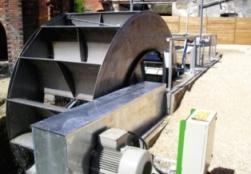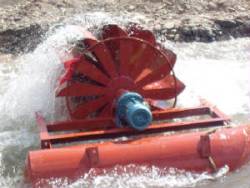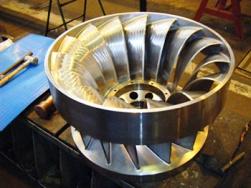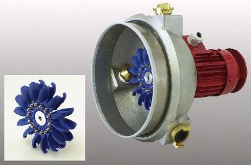Categories: Sharing experience, Interesting electrical news
Number of views: 229,937
Comments on the article: 24
Home-made mini-hydroelectric power station and its industrial analogues
 The article describes and experiences the use of various home-made and industrial mini-hydroelectric power stations.
The article describes and experiences the use of various home-made and industrial mini-hydroelectric power stations.
Recently, due to the increase in electricity tariffs, renewable sources of almost free energy are becoming increasingly relevant.
From the famous classic triad: solar panels, wind generators, hydrogenerators (HPS), the latter are the most complex. Firstly, they work in aggressive conditions, and secondly, they have maximum operating time for an equal period of time.
In the manufacture of a makeshift hydrogenerator, you need to work harder and choose better materials to ensure its durability. But such a generator (with equal power with a wind turbine and a solar battery) will produce, for an equal period of time, much more energy.
What and how to do?
The easiest way to do damless hydroelectric power stations, because dam construction is quite complex and expensive and often requires coordination with local authorities or, at least, with neighbors. Damless hydroelectric power stations are called flowing. There are four main options for such devices: a water wheel, a garland hydroelectric power station, a Darier rotor and a propeller.
Types of mini-hydro
 Water wheel, This is a wheel with blades mounted perpendicular to the surface of the water. The wheel is less than half submerged in the stream. Water presses on the blades and rotates the wheel. There are also turbine wheels with special blades optimized for a fluid stream. But these are rather complex designs, rather factory-made than home-made.
Water wheel, This is a wheel with blades mounted perpendicular to the surface of the water. The wheel is less than half submerged in the stream. Water presses on the blades and rotates the wheel. There are also turbine wheels with special blades optimized for a fluid stream. But these are rather complex designs, rather factory-made than home-made.
Garland hydroelectric power station represents a cable, with rotors rigidly fixed on it. A cable is thrown from one river bank to another. The rotors are like beads strung on a cable and completely immersed in water. The flow of water rotates the rotors, the rotors rotate the cable. One end of the cable is connected to the bearing, the other to the generator shaft.
Rotor darya, This is a vertical rotor that rotates due to the pressure difference on its blades. The pressure difference is created by the flow of fluid over complex surfaces. The effect is similar to the lift of hydrofoils or the lift of an airplane wing.
Propeller - This is an underwater “windmill” with a vertical rotor. Unlike air, the underwater propeller has blades of minimum width. For water, a blade width of only 2 cm is sufficient. With this width, there will be a minimum resistance and a maximum rotation speed. This blade width was selected for a flow rate of 0.8-2 meters per second. At high speeds, other sizes may be optimal.
See also here:Mini and micro hydropower plants - popular designs and applications
Advantages and disadvantages of various systems to create a makeshift hydroelectric station
disadvantages garland hydroelectric power station obvious: high material consumption, danger to others (a long underwater cable, rotors hidden in the water, blocking the river), low efficiency. Garland hydroelectric power station is a small dam. Rotor darya difficult to manufacture, at the beginning of work it needs to be untwisted. But it is attractive in that the rotor axis is located vertically and power take-off can be performed above the water, without additional gears. Such a rotor will rotate with any change in flow direction.
Thus, from the point of view of simplicity of manufacture and obtaining maximum efficiency with minimal cost, it is necessary to choose a design of the type water wheel or propeller. Most homemade products use these very options.
Where to begin?
 If you decide build your mini hydro, then the first thing to do is to measure the speed of the river. To accomplish this is quite simple: arm yourself with a stopwatch, measure in steps of 10 meters upstream, throw a sliver into the water and measure the passage time of these 10 meters.By dividing the meters by seconds, you get the flow rate. Experience has shown that if the speed is less than 1 m / s, then an effective hydroelectric station will not work.
If you decide build your mini hydro, then the first thing to do is to measure the speed of the river. To accomplish this is quite simple: arm yourself with a stopwatch, measure in steps of 10 meters upstream, throw a sliver into the water and measure the passage time of these 10 meters.By dividing the meters by seconds, you get the flow rate. Experience has shown that if the speed is less than 1 m / s, then an effective hydroelectric station will not work.
For example, we can cite the relationship obtained experimentally between the flow rate m / s and the power removed from the shaft of the screw kW (screw diameter 1 meter). So: 0.5 m / s - 0.03 kW, 0.7 m / s - 0.07 kW, 1 - 0.14, 1.5 - 0.31, 2 - 0.55, 2.5 - 0.86, 3 -1.24, 4 - 2.2, etc. Power is proportional to the cube of the flow velocity. If the flow rate in your pond is insufficient, try to arrange a sufficient height difference for the fluid flow.
This can be done by installing a drain pipe from a pond or by enclosing a stream in a pipe and organizing a smooth change in the diameter of the pipe. The smaller the diameter at the end of the pipe, the greater the flow rate. If only a small stream flows near you, then you can make a small collapsible dam, and put your hydroelectric station behind the dam.
Production Examples
Can lead some examples of homemade mini hydroelectric power plants. Let's start with the simplest, which does not take you much time, but helps to create an idea of how it works.
Take a regular bike with a bicycle generator (dynamo machine) and bike lights. From the roofing iron or from sheet aluminum, we cut out several blades (2-3). The blades should be the length from the wheel rim to the hub, and 2-4 cm wide. The blades are installed between the spokes, for fixing their edges they are bent with pliers around the spokes. Since the metal of the blades is thin, it is not difficult to do.
If you use two blades, then install them opposite each other. If you want to add more blades, divide the wheel circumference by the number of blades and set them at regular intervals.
Such a micro hydroelectric station is of great help to cycling tourists if they stopped on the bank of a river with a fast current. Water will help light the tent and charge cell phones. You can experiment with the depth of the wheels. Usually it is immersed from one third to half.
Another example of a hydrogenerator is micro-hydroelectric power station for power supply of a small farm, with a capacity of 3-5 kW. The power flow that rotates the wheel is approximately 100 liters per second. For the manufacture of used only improvised materials, of those. What can be found in the landfill.
The rotor wheel was made of a metal drum from a cable. The diameter of the drum is 2200 mm. The drum was cut with a grinder and digested. The distance between the cheeks was 300 mm. At an angle of 45 degrees to the radius, 18 blades were welded. The material of the blades is the remains of the cut drum. The drum rotates on bearings, a frame of pipes or corners is used as a support for the structure.
A chain gearbox is mounted on the wheel, with a gear ratio of four. Further, the rotation is transmitted through the driveshaft from the VAZ 2101 Zhiguli. The cardan can reduce vibration and reduce the requirements for alignment of the drive and generator. The generator and other electrics and mechanics associated with it are closed by a waterproof casing (container). This is done for safety and durability.
Inside the casing, a step-up gearbox with a coefficient of 40 and a three-phase generator are installed. The rotation speed of the generator is approximately 3000 rpm. The total reduction coefficient of two gearboxes (chain and gear) 160. Thus, the water wheel rotates at a speed of about 18-20 revolutions per minute.
A decommissioned induction motor was used as a generator; the control unit was taken from an old decommissioned feed crusher manufactured in 1953. A cable of VVG NG 2x4 squares is stretched from the generator to the farm. The cable is mounted on makeshift poles.
Materials and manufacturing cost 10,000 rubles. Most of the money is the salary of workers and a welder. The amount may be even less, because in Russia there are so many landfills where completely efficient equipment is thrown and your own head and hands will save you money.
What industry offers
 Currently, few domestic enterprises offer mini hydro at reasonable prices. For example, a similar mini HPP (3-5 kW) would cost 300-400 thousand rubles. More details about the specifics of the issue can be found at the links:
Currently, few domestic enterprises offer mini hydro at reasonable prices. For example, a similar mini HPP (3-5 kW) would cost 300-400 thousand rubles. More details about the specifics of the issue can be found at the links:
The longer you live, the more you realize that the crisis is nesting in the heads of our leaders. Russia is a self-sufficient country, because it has everything - resources, talented people and a million directions for those who want to change something for the better. We have something to strive for - the longest way begins with the first step. Do it and describe your achievements. Share your experience.
See also at e.imadeself.com
:
